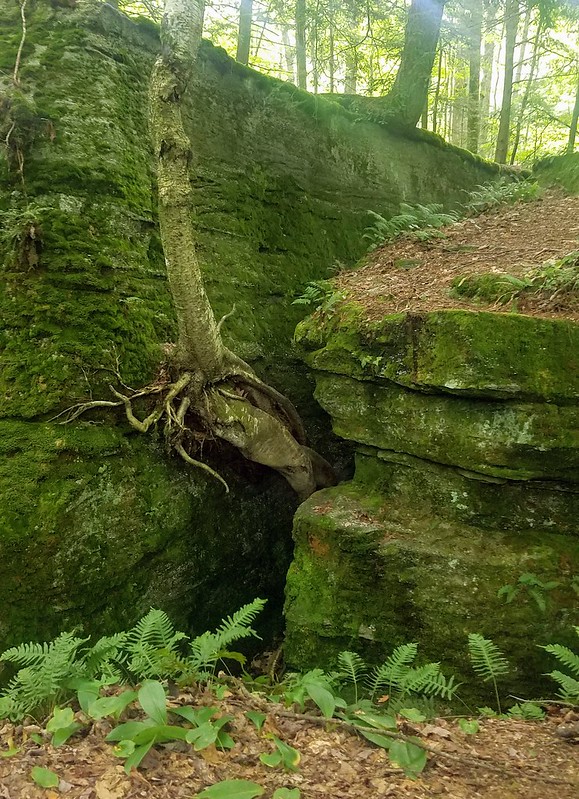Every Friday for the last few weeks, a couple of the kids attending ACNC’s Outdoor Classroom program have spent part of the afternoon hike collecting rocks. Audubon sits on a wetland and as such does not have an overabundance of large rocks, so the rocks they find are mostly those that have been put down with gravel or the occasional smaller one found on the trail. Most people walk right over them without a second thought, but these seemingly uninteresting rocks are immensely important to the kids who find them.
A little sparkle, a hint of pink or an entirely smooth rock is magnified by their interest and connection with this rock because they have made the choice to claim it as their own. It is now their rock that they put time and energy into choosing, picking or digging up and carrying with them. At the end of the day, many of these rocks are left behind for others to discover and a couple are brought home to add to their rock collection.
Rocks are literally everywhere. They make up the ground we stand on, but for many adults they only become the star of the show when they are impressively large and in our face. As with many of the things in nature that seem mundane, there is a lot more going on with them than we can see in a brief moment.

A challenge I sometimes pose to students is asking them to find the smallest rock they can and bring it back to the group. Many begin with a rock that is about half an inch in diameter, and as they continue to look they get smaller and smaller. After a minute or so, I bring them back and have them all present their rocks, which are usually pretty impressively small. I then show them what I picked up. I hold out a handful of soil.
Soil is made from a couple different components including biotic, or living things, and abiotic, or non-living, materials. The biotic factors could be currently and once living plants and animals. A large percentage of organic matter consists of the remains of decomposed plants and animals.
The abiotic factors actually make up a much larger percentage of the soil than the biotic one. Minerals, water, and air are the main abiotic components, but they occur in different proportions depending on location and other environmental influences. Organizations, such as the Natural Resources Conservation Service (NRCS), have created soil maps and profiles for much of the United States, and the composition of soil from region to region has long influenced how that land is managed. It is also part of the reason different crops are grown in different states.
Minerals make up far more of the soil than decomposing plants and animals, but it is not as obvious where all of those minerals came from. A lot of the non-organic solids in soil are created by the processes of weathering and erosion of rocks. While holding out a handful of soil and calling it a tiny rock is not an entirely accurate definition of a rock as an object, it introduces the origins of the minerals and abiotic solids in the soil.
You have probably heard of erosion. However, what we often think of as erosion is actually weathering. Semantics, I know, but they are two independent steps of the process. Weathering is the breaking down of rocks through mechanical and chemical means such as water, ice, wind, animals physically wearing it down, or even plant roots growing next to or on top of rocks. Erosion is the movement of these weathered rock pieces to a new location.

A fair amount of the original minerals that make up new soil comes from the weathering of lava flow bedrock deep underground. However, some of the minerals in soil come from those rocks above ground too. Have you ever found a perfectly smooth rock at the bottom of a stream? That rock has undergone weathering from the water constantly passing over it and wearing off tiny bits at a time. Those sediments sometimes settle to the bottom, but usually the water contributes to erosion by continuing to move the sediment downstream. That’s how rivers and stream form. Well, some formed when glaciers came by and slowly carved out the rock and soil. Either way, the gorges and river beds are just a product of the erosion and weathering of rocks on a very large and very long timescale. If you have ever been to a rock city or climbed a mountain up to a bare rock face, you have also seen the effects of weathering and erosion on rocks, as soil is brought away by wind, water, and in the most popular hiking areas, foot traffic.
Rocks are immensely difficult to see as a changing or influential force because it takes decades, centuries, or longer to see a large difference in their formation or disintegration. Watching a rock erode takes more time than watching paint dry. It’s just not an exciting process in the short term, but when you think of it over long periods of time, rocks have moved and changed to shape and re-shape the areas we live in. Even the rocks we find to add to the student’s collections have been undergoing a long process that will most likely continue for decades to come.
Audubon Community Nature Center builds and nurtures connections between people and nature. ACNC is located just east of Route 62 between Warren and Jamestown. The trails are still open from dawn to dusk but Liberty, the Bald Eagle is currently off display during the construction of the Pamela A. Westrom Wildlife Habitat. You can visit her on her Facebook page. The Nature Center is partially open, including restrooms, the Blue Heron Gift Shop, and some exhibits. More information can be found online at auduboncnc.org or by calling (716) 569-2345.


Recent Comments